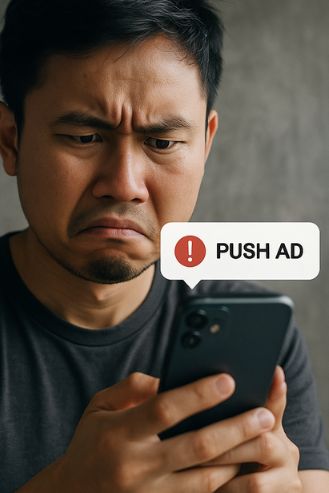
5 Common Push Ad Mistakes and How to Fix Them
Push ad mistakes can quietly drain your budget, stall conversions, and sour your view of what is otherwise a powerful, privacy-friendly ad channel. The good news is that most performance issues with push ads come from a small set of fixable problems: targeting that’s too broad or misaligned, weak creative that fails to earn the click, over-frequency that causes fatigue, poor context control across devices or time windows, and weak measurement that hides where profit really comes from. In this guide, you’ll learn practical steps to find, fix, and prevent these issues so you can scale push with confidence.
Push ads have evolved rapidly in recent years, especially as advertisers look for cookie-light, consent-driven ways to reach audiences. If you’ve struggled with quality or scalability before, don’t give up—modern optimization tools and creative frameworks make a huge difference. For broader context on how the channel is changing and why it remains effective, see this helpful overview on how push ads are evolving to stay both privacy-friendly and powerful.

Mistake #1: Targeting Everyone (and Converting No One)
When targeting is too broad, your CTR dips, your CPC rises, and your conversion rate struggles. Push inventory is wide and fast; if your audience definition and placements are not aligned with your offer, you’ll spend a lot on uninterested users. Common symptoms include extremely low click-through rates on first launch, high bounce rates on landers, and no improvement after a few bid changes.
How to fix it: Tighten the who, where, and when. Start by defining your highest-probability user segments—geo, language, device, OS version, and interests if available. Launch with a “narrow-first” approach (fewer geos, strongest affinity placements), then expand after you see positive signals. For inspiration and competitive context, analyze top angles and headlines with ad research tools and vertical reports; platforms and third-party resources can reveal which hooks resonate. Tools like Anstrex Push Ads are useful for spotting creative patterns, device splits, and lander styles in your niche.
Quick Targeting Checklist
- Define your ICP: geo, language, device, OS, and intent cues.
- Start with top-5 geos and proven vertical placements before broadening.
- Exclude regions/timezones that historically underperform for your offer.
- Use separate campaigns for distinct devices (Android vs. Windows) to isolate CPAs.
Mistake #2: Creative That Fails to Win the Click
Push creatives live or die by the thumbnail and the first 40–60 characters. If your image doesn’t pop or your message isn’t specific, curiosity never turns into a click. Generic stock icons, buzzword-stuffed headlines, or claims with no context are the biggest culprits. CTR is your early truth-teller—if it’s under benchmark (varies by network and geo), prioritize creative iteration over bid changes.
How to fix creative—step by step
- Clarify the promise: What immediate benefit will the user get? Lead with that.
- Make the visual do real work: Faces, clear symbols, or product-in-action beats generic icons.
- Use friction-lowering microcopy: Words like “free,” “quick,” “demo,” or “today” can lift CTR when truthful.
- Test in batches: Launch 6–10 variations at once (headline × image), then keep the top 20% and replace the rest.
- Localize properly: Don’t just translate—adapt idioms and visuals to the culture.
Mistake #3: Over-Frequency and Audience Fatigue
Push can overexpose the same users quickly, especially in narrow geos or smaller subscriber pools. If your frequency is too high, performance decays: CTR falls, CPC rises, and conversions sink. Users begin to tune out your brand, and you may even see an uptick in unsubscribes or negative feedback.
How to fix frequency issues
- Cap impressions per user: Start conservatively (e.g., 1–2/day, 5–7/week) and expand after success.
- Rotate creatives by audience: Assign creative sets to cohorts so people don’t see the same angle twice in a row.
- Use recency windows: Pause users who saw an impression in the last X hours if your funnel benefits from novelty.
- Stage campaigns: Run a prospecting campaign and a retargeting campaign with different caps and creatives.
Mistake #4: Ignoring Device, Timing, and Context
Performance can swing dramatically by device (Android vs. desktop), OS version, time of day, and even day of week. Many teams push a winning bid and creative across all contexts and then wonder why volatility spikes. Context mismatches show up as erratic CTR and inconsistent CPA from one slice to the next.
Fix context—make it deliberate
- Split by device and OS: Separate campaigns to isolate bids, caps, and creatives by environment.
- Daypart: Start with obvious windows (commute, lunch, after work) in each geo; expand with data.
- Adjust creative to context: Work hours? Lead with utility. Evenings? Lead with relief/entertainment.
- Audit lander readiness: Ensure page speed, fonts, and CTAs render crisply on the top devices that click.
Mistake #5: Weak Measurement and Optimization Loops
If you can’t see which creative-device-geo combos generate profits, you’ll make guesses rather than decisions. Common measurement errors include tracking only clicks, not post-click events; failing to pass subIDs and placement IDs; and lumping all contexts into one campaign so signals are muddy.
Build a reliable improvement loop
- Track the full funnel: Pass click IDs, subIDs, and placement IDs through to your analytics and back to the network.
- Define a learning budget: Commit a fixed amount for statistically valid tests (creative, device, geo).
- Promote winners quickly: Duplicate winning ad sets into new campaigns with more budget and stricter caps.
- Kill laggards ruthlessly: If a creative underperforms after a fair test window, pause it and replace it.
Putting It All Together: A 14-Day Push Ads Action Plan
- Day 1–2: Define ICP, pick 3–5 geos, split device campaigns, set conservative caps.
- Day 3–4: Produce 10–12 creative variations: 3 images × 4 headlines; localize if needed.
- Day 5–6: Launch tests with clean tracking; verify events fire (view, click, add to cart, lead, purchase).
- Day 7: Cull bottom 50% creatives; promote top 20%; iterate the middle 30% with 1–2 major angle shifts.
- Day 8–10: Expand time windows and an additional 1–2 geos; keep device splits separate.
- Day 11–12: Review placement/zone data; exclude outliers; refine frequency caps by campaign.
- Day 13–14: Scale budgets on proven combos; queue the next creative batch before fatigue hits.
Creative frameworks to try:
- Problem → Agitate → Solve: Name the pain, raise the stakes, present the fix.
- Before/After Bridge: Visualize life before your product and after, then show the bridge.
- Social Proof Punch: Numbers or testimonials (truthful, verifiable) near the headline.
- Micro-Urgency: Limited-time perks or bonuses tied to actual availability or calendar events.
FAQs
How many creatives should I test at once?
Launch at least 6–10 variations to give yourself room for meaningful comparison. Too few and you risk drawing conclusions from noise; too many and your budget gets spread too thin. The sweet spot balances breadth with enough impressions per variant to be confident.
What is a good CTR for push ads?
Benchmarks vary widely by geo, device, and vertical. Treat your first 72 hours as baseline-gathering time, then aim to beat your own median CTR by 20–30% with each creative batch. Tracking improvement over time is more actionable than chasing a global number.
Should I use spy tools?
Competitor research helps you see themes that work in your niche. Use insights responsibly to guide angle ideation, then build original, high-quality creatives and landers. Focus on your user’s needs, not clones of someone else’s ad.
Conclusion
Most push ad mistakes are avoidable once you tighten targeting, respect frequency, make context deliberate, and build a trustworthy measurement loop. Keep your iteration tempo high and your learning budget protected. For broader perspective and community angles on what trips up advertisers (and how they recover), check out this Quora discussion—even though it’s about another platform, the lessons translate well. Above all, commit to a steady cycle of testing and promotion of winners, and push ads will become a scalable, durable part of your acquisition mix.


